How to Play Here I Go Again Solo
Grant Green was ane of the finest soloists to ever play jazz guitar. His playing was bluesy, full of bebop vocabulary, and swung hard no thing what situation he was in. Grant Green was a master jazz guitarist of the highest level, and it is definitely a good idea to spend some fourth dimension learning Grant Light-green licks in your jazz guitar practice routine.
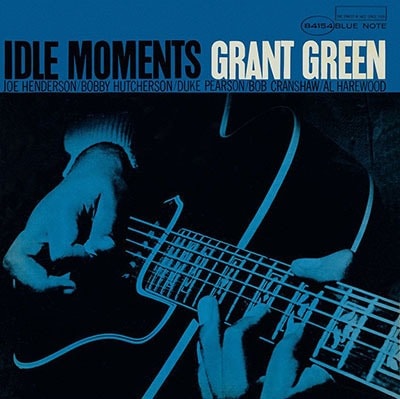
Known equally a bluesy thespian (and afterwards, the father of modern funk), Grant Dark-green was also a talented bebop soloist who had a potent handle on bebop vocabulary and substitutions.
In this lesson, y'all will report Grant Green's guitar playing style. Yous will learn several Grant Greenish licks, but beyond the licks, you'll learn the edifice blocks for each phrase so that you lot know how to create your own Grant Light-green-sounding licks.
If you are looking to get some classic blues licks under your fingers, aggrandize your bebop vocabulary, and piece of work on your swing all at the same time, then Grant Light-green is the man to study.
Lesson Contents
- Idle Moments
- Grant Greenish Lick ane – two Five I in F Major
- Grant Green Lick 2 – ii V I in F Major
- Grant Light-green Lick 3 – 2 V I in F Major
- Grant Dark-green Lick 4 – ii V I in F Major
- Grant Green Lick v – Dominant
- Grant Dark-green Lick 6 – ii V I in Bb
- Am7b5 over Cm7
- Ebmaj7 over Cm7
- The Altered Scale
- C Minor Triad over F7
- Approach Notes
- Lower Neighbor Notes
- Grant Green Blues Solo
- Grant Green Soloing – Ascendant Chord Concepts
- V7alt Lines Going to Major
- Dominant Bebop Lines
- V7alt Lines Going to Minor
- Solar Solo
Idle Moments
Idle moments is the almost famous melody on Grant Green's album Idle Moments, released in 1965. The song is written by piano player and Blueish Note producer Duke Pearson.
In this department, you will acquire the theme of Idle moments, which is a lot of fun to play.
Backing Track
Heed & Play Along
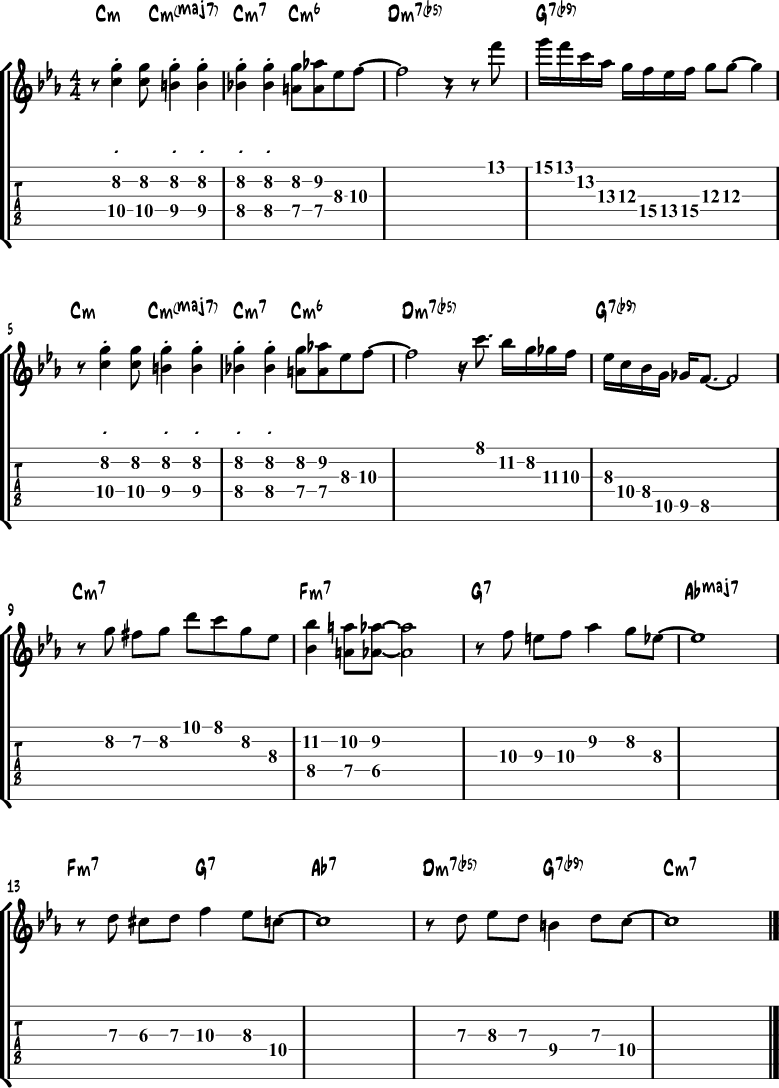
Grant Green Lick 1 – ii Five I in F Minor
This first lick uses two classic Grant Green approaches to minor key ii-Vs.
- The Edim7 arpeggio in bar i implies a C7b9 chord. Edim7 outlines the 3rd, 5th, b7 and b9 of C7, creating a rootless arpeggio in this instance.
- The descending notes (C and Bb) over the pedal annotation G in the second half of bar i is another idiomatic Grant Dark-green approach to edifice lines in this context.
Listen & Play Along

Grant Greenish Lick 2 – ii V I in F Major
The side by side lick uses the G melodic small-scale scale over Gm7 in bar one, implying a GmMaj7 sound.
Applying the melodic minor calibration to the iim7 chord is a characteristic of Grant's playing, and it can be heard farther during his solo over So What, where he uses melodic minor over large portions of that melody.
Listen & Play Forth

Grant Green Lick iii – ii V I in F Major
The adjacent 2 V I lick uses a few chord substitutions to create a focus on the iim7 chord. In this case by playing Gm7-D7b9-Gm7, rather than outlining the written changes.
This type of commutation, playing a V7b9/iim7 in the centre of a two 5 I, is something Grant Green loved to practise and it's a bully way to aggrandize your ii Five I vocabulary.
Listen & Play Along

Grant Green Lick iv – ii V I in F Major
This lick uses a quick turnaround substitution over the last 2 bars of the phrase.
Rather than just playing over the Fmaj7 chord that's in the progression, Grant would like to use turnarounds to create more involvement over a static chord.
In this case, you lot can see the Imaj7-bIII-bVI-bII-Imaj7 turnaround existence used. This turnaround progression is otherwise known equally the Ladybird turnaround since it is the last ii bars of the Tadd Dameron tune Ladybird.
Listen & Play Along

Grant Green Lick 5 – Dominant
This is a pretty straight-forwards dominant 7 lick in the style of Grant Green.
Here are two items worth looking at further in your practicing:
- The starting time is the use of the note C (the b3) to create a bluesy sound over the A7 chord.
- The second is the concluding 4 notes. This is a mutual bebop phrase where you play one note (F#) and then want to play the note below it (E) merely you become there past playing the diatonic ascending triad to that note (in this case an A major triad).
Heed & Play Along

Grant Green Lick 6 – two V I in B Flat
Here is a lick over a ii 5 that goes to Bb7.
There's a lot going on in this lick, of which you will acquire more than well-nigh below.
Mind & Play Along

Hither are the concepts used in this line that you lot can acquire, practise, and expand upon in your soloing.
Am7b5 Over Cm7
The beginning concept in this lick has Grant Green using an Am7b5 arpeggio over a Cm7 chord.
When doing so, he creates a Cm6 sound in his line.
| Am7b5 | A | C | Eb | G |
|---|---|---|---|---|
| Played over Cm | 6 | i | b3 | 5 |
Equally a dominion, you can use a m7b5 arpeggio from the 6 of a m7 chord to create a m6 audio in your lines.
Here's how that looks and sounds:
Heed & Play Along

Ebmaj7 Over Cm7
You can likewise play an Ebmaj7 arpeggio over a Cm7 chord, creating the intervals b3-5-b7-nine.
| Ebmaj7 | Eb | 1000 | Bb | D |
|---|---|---|---|---|
| Played over Cm | b3 | 5 | b7 | 9 |
As a rule, you can play a maj7 arpeggio from the b3 of any m7 chord to produce a rootless m9 sound.
Hither's how that concept looks and sounds so you can start to accept it onto the guitar.
Mind & Play Along

The Altered Scale
The altered scale is found in the solos of every keen jazz guitarist, including Grant Green.
Below it is seen in the #9-b9 notes.
When used over 7th chords, the altered scale highlights the b9,#nine,b5, and #5 intervals. Because of this, the scale creates a lot of tension that you accept to address in your solos.
| F Altered Calibration | F | Gb | Chiliad# | A | Cb | Db | Eb |
|---|---|---|---|---|---|---|---|
| 1 | b9 | #9 | 3 | b5 | b13 | b7 |
Here are two fingerings for the contradistinct scale to get you started with this important audio on the guitar.
Listen & Play Along
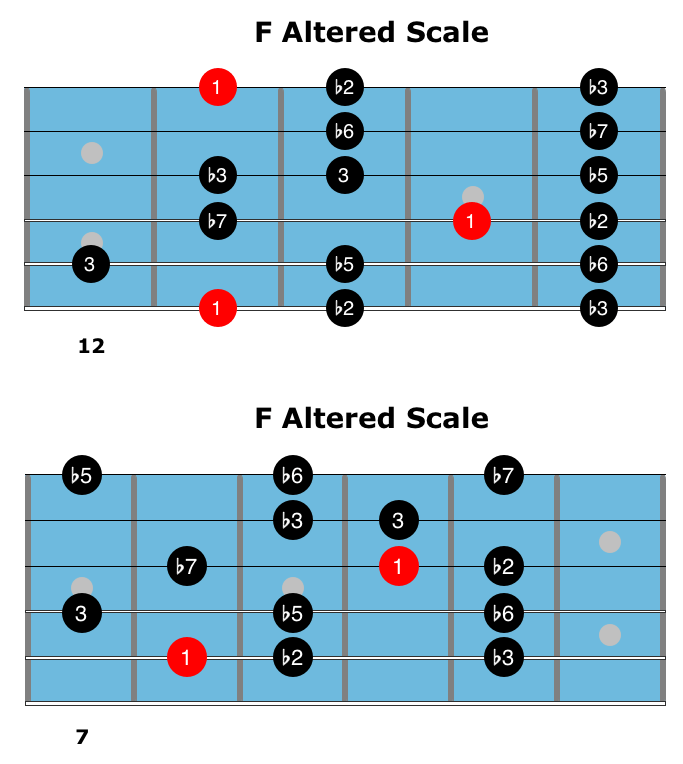
Cm Triad over F7
Yous likewise see a Cm triad over F7 in the line, which outlines the 5-b7-9 intervals of the F7 chord.
| Cm Triad | C | Eb | G |
|---|---|---|---|
| Played over F7 | 5 | b7 | 9 |
As a dominion, you can play a minor triad from the fifth of whatsoever 7th chord.
Hither'south how that looks and sounds:
Listen & Play Along

Approach Notes
Arroyo notes are chromatic notes that lead by half stride into diatonic notes.
Most ofttimes they are used beneath diatonic notes, but yous can too use them above.
In this lick, you see this equally the B-C notes in the final bar.
Hither'southward how an arroyo note below looks like on paper:
Listen & Play Along

Lower Neighbour Notes
The final concept is the lower neighbour tone, which you lot tin can see as LN in the guitar tabs beneath.
Lower neighbour notes are when you have a diatonic note (C for case), then you play a notation simply below that note (B) so back to the diatonic note (C).
So, C-B-C, with the B being the lower neighbor tone.
Here'southward how that looks on paper:
Listen & Play Along

Grant Light-green Dejection Solo
To accept this lick further, here'due south a jazz blues solo that uses typical Grant Greenish lines, as well as the exact lick in the final four confined.
Learn the solo as is, then begin to integrate these ideas into your soloing vocabulary from there.
Backing Track
Listen & Play Forth
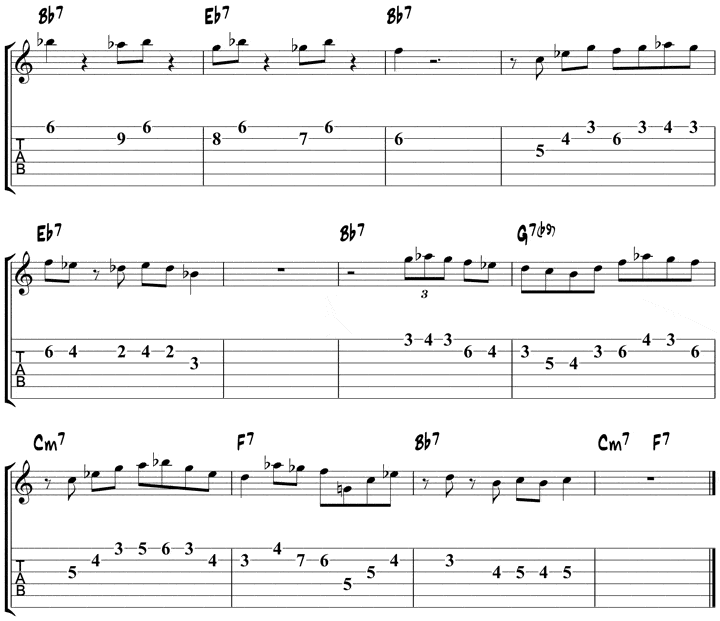
Grant Green Soloing – Ascendant Chord Concepts
In this section, yous will focus on Grant Green's dominant seventh concepts.
Y'all'll zoom in on three main ideas in this lesson. Past working on V7alt lines in major and minor keys, as well as the dominant bebop calibration, y'all'll get a glimpse into the playing manner of one of jazz's greatest guitarists.
Check these lines out, work the concepts behind them farther in your playing, and when ready, learn the sample solo at the end of the section.
Grant Dark-green Soloing – Major V7alt Lines
To brainstorm your study of Grant Green dominant chord concepts, you volition look at how Grant added altered notes to major key V7 chords.
Normally yous recollect of adding altered notes (b9, #9, …) to modest central V7 chords, but you can employ them in major keys as well.
Hither are 2 examples of Grant using V7alt chords to create tension and resolution in his major primal ii V I soloing lines.
The first line uses the b9 and #9 over the V7 chord in a ii Five I progression in Eb major.
Discover how the altered notes are so resolved to the root annotation of the underlying chord. As the root is a very strong chord tone (the strongest in fact), this line has a strong resolution.
This allows for the altered notes to create tension and resolution, rather than merely tension, which can cause your lines to sound out of place without that resolution.
Mind & Play Along

In this second major 2 V I line, again the b9 and #9 are used over the V7 chord to create tension. These notes are resolved to the note Bb, the 5th of Ebmaj7.
Alongside the altered notes, there's a raised 7th interval over the Fm7 chord, creating a melodic minor sound over this chord.
Listen & Play Along

Grant Green Soloing – Dominant Bebop Lines
Some other way that Grant liked to spice up his dominant 7th lines is to use the ascendant bebop scale over that chord.
The dominant bebop scale is a Mixolydian scale with an added 7thursday note.
| Mixolydian Scale | 1 | 2 | iii | 4 | five | vi | b7 | |
|---|---|---|---|---|---|---|---|---|
| Bebop Scale | 1 | two | 3 | 4 | v | 6 | b7 | seven |
In this first bebop calibration phrase, the Bb ascendant bebop scale is used in bar one, in anticipation of the Bb7 in bar 2 of the phrase.
Observe that the major 7 interval (A) is placed on the 4th beat of the bar.
As long every bit y'all resolve the passing note in a bebop calibration you can place information technology anywhere in the bar you lot delight. Simply, if yous don't resolve that note, either downwardly to the b7 or upward to the root, it'll sound out of identify no affair where you lot employ it in your line.
Listen & Play Along

The next bebop line again uses the Bb dominant bebop scale in bar i of a ii V I, where Grant is thinking V7-V7-I.
You'll notice the A (the bebop annotation) accented on beat two of the phrase, before beingness resolved into beat out three on the Ab.
Mind & Play Along

Grant Greenish Soloing – Minor V7alt Lines
Too as using altered notes over major V7 chords, Grant too brought these tension notes into his small central solos.
In this department, you volition wait at two ways to bring altered notes into your V7 lines:
- Dim7 arpeggios
- Adding b9 and #9 over the underlying chord
One of Grant's favorite ways to colour V7 chords in a small key is with a three to b9 arpeggio, which you tin see in the line below.
Past playing Bdim7 over G7alt, Grant highlights the iii, 5, b7, and b9 intervals of the underlying chord.
| Bdim7 | B | D | F | Ab |
|---|---|---|---|---|
| Played over G7 | 3 | 5 | b7 | b9 |
When soloing over dominant chords, you can always play a dim7 arpeggio from the 3rd of that dominant chord to create a b9 arpeggio.
Notice that here Grant resolves that b9 into the root and downwardly to the b3 of Cm7 (Eb).
Listen & Play Along

The adjacent minor V7alt lick uses the b9, #9, and #four to create tension over that bar in the phrase, before resolving that tension over Cm7. Starting a V7alt line with a b9-#9-b9 triplet is a mutual way to add together those tension notes to your lines.
From in that location, the C# (#iv) is used equally a lower neighbor tone, resolving up to the D (5) of the underlying chord.
Listen & Play Along

Grant Green Soloing – Solar Solo
In this Solar solo, you'll apply most of the previous lines to create a one-chorus solo etude that you lot tin learn and work into your own playing.
Notice the double-fourth dimension lick in the terminal phrase, which is a lick yous've already learned, though this time played twice as fast to fit into the space given to those chords.
When working on fast licks, such as 16th-note phrases, you tin frequently just accept a normal lick and play it twice as fast. This approach is existence used here to squeeze that lick into two bars, rather than four bars.
Backing Rail
Listen & Play Along
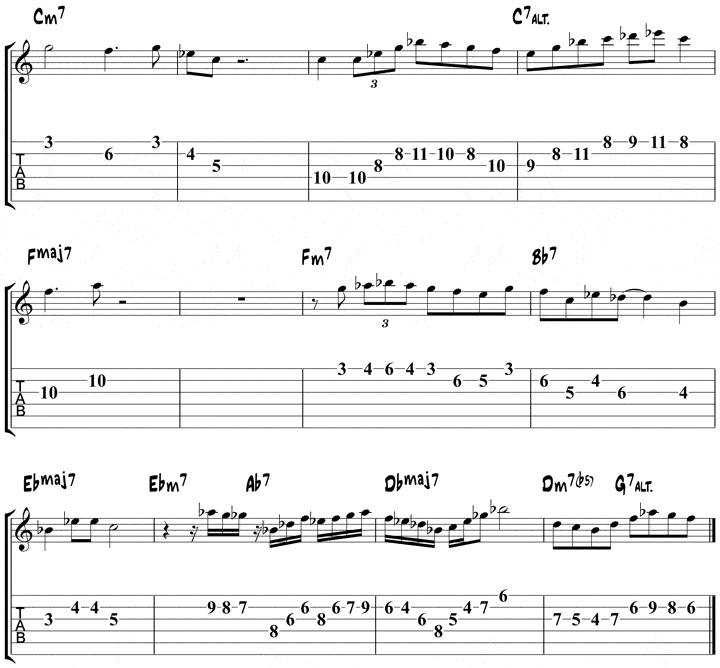
Source: https://www.jazzguitar.be/blog/grant-green/

0 Response to "How to Play Here I Go Again Solo"
Post a Comment